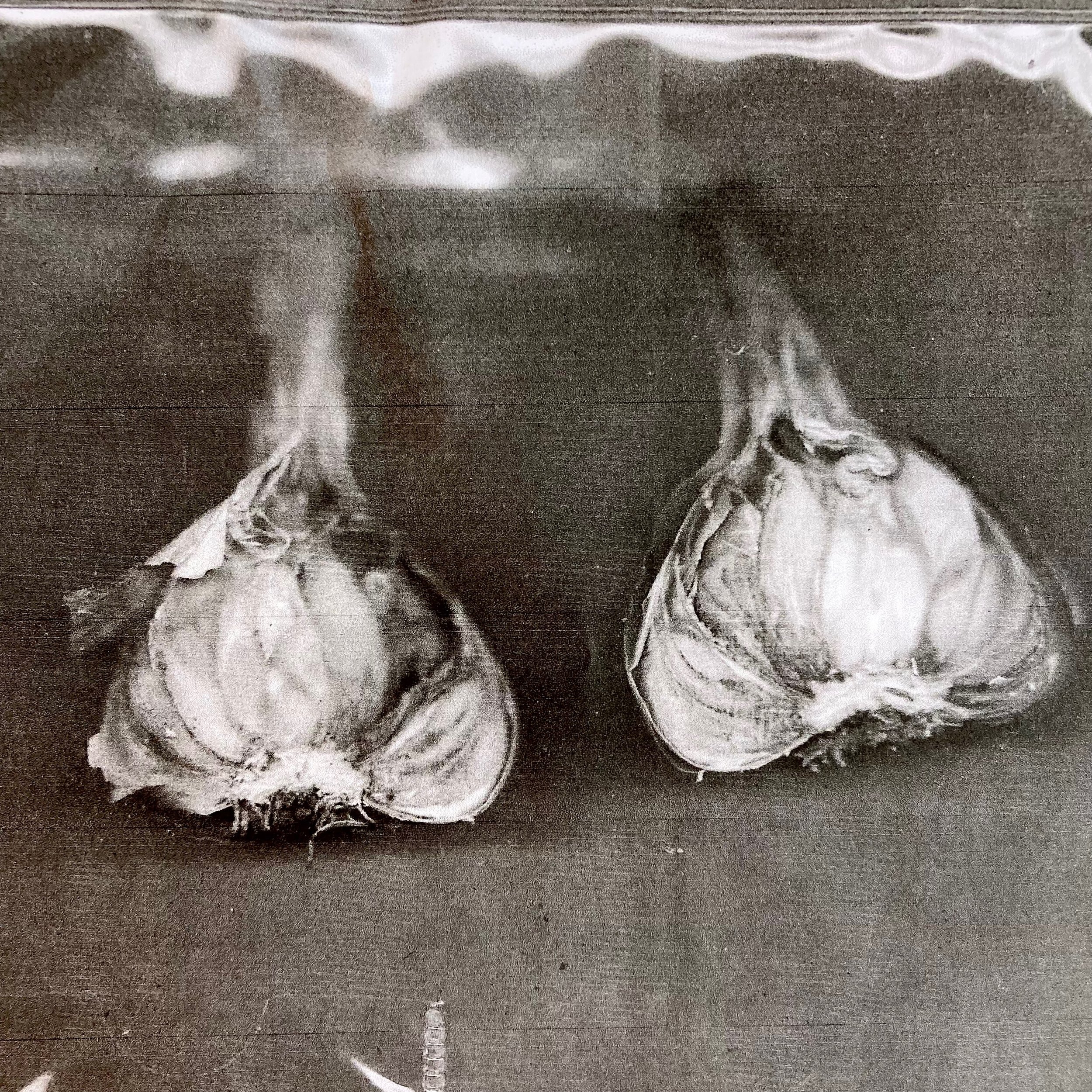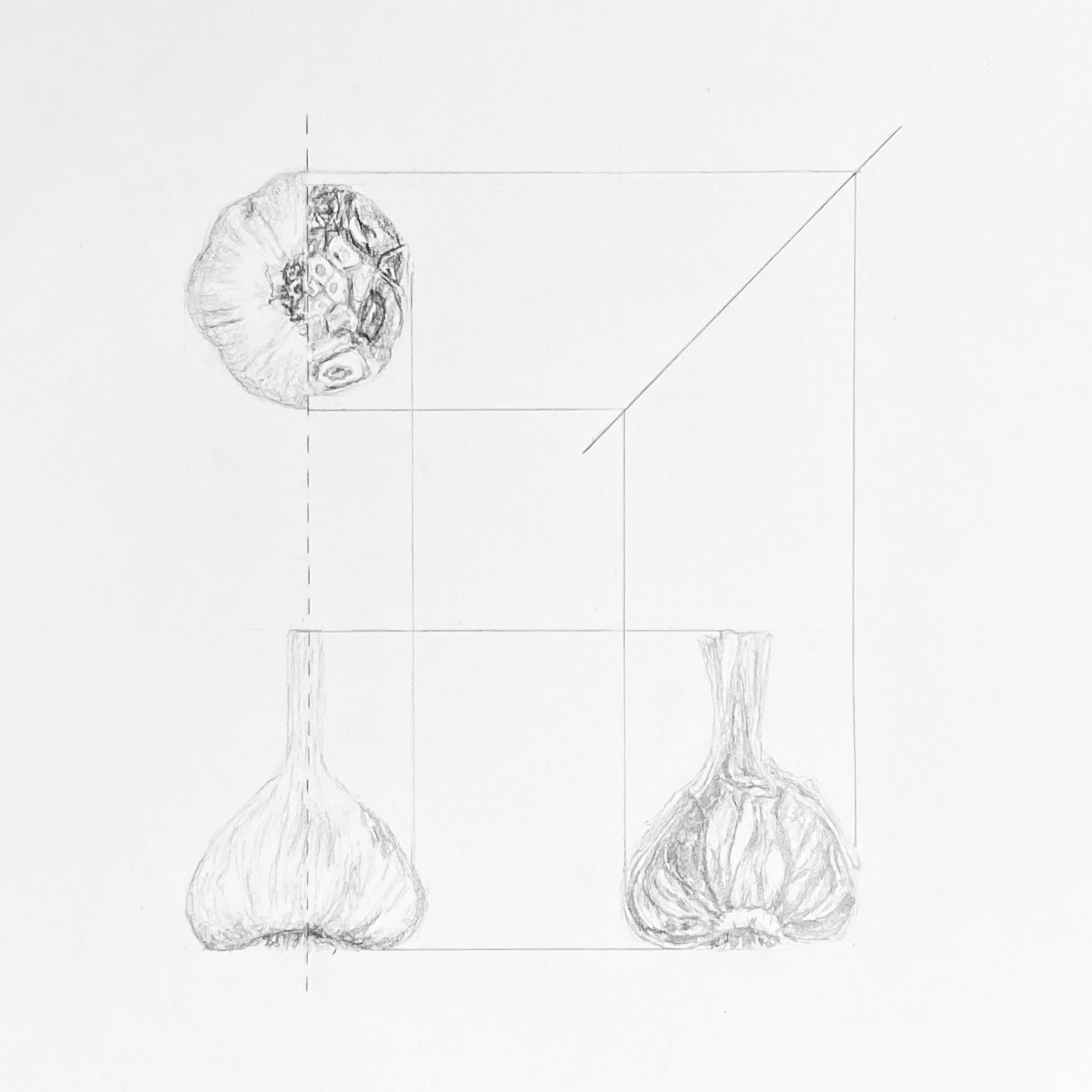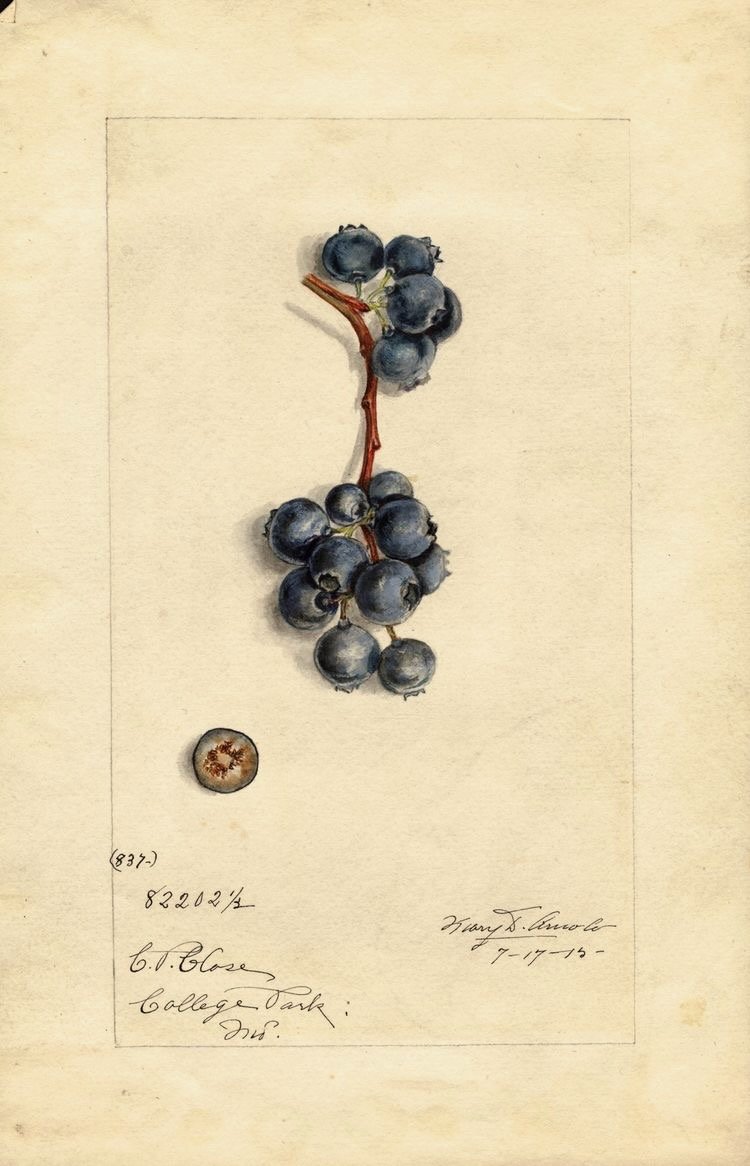Garlic bulb - Orthographic drawing
ORTHOGRAPHIC DRAWING / DIAGRAMMATICAL TRANSLATIONS
This project transitions from hand drawn to digital orthographic design developing skills in hand pencil drawing, Adobe Photoshop, and Illustrator to communicate through scientific and botanical visual representation. This Project is divided into four parts, two of which require hand drawings orthographic representations of subject, and two of which are diagrammatical interpretation
AT3.1 (Part 1 & 3) Orthographic Hand drawing using elevational/top, sectional/side, and combination/top & side views.
AT3.2 (Part 2 & 4) Diagrammatical Design using adapted subject research, scientific visual representational tools such as chain or dash lines, modelling figures, stippling, and tonal gradation.
Orthographic translation into diagrammatical representations will require you to investigate your selected subject matter (organic form of your own choosing and shared student drawings), through visual analysis of
whole and parts of form,
deeper research into biological aspects of object
and the connections between macroscopic, the microscopic, and symbolic levels of representations when developing diagrammatic artworks.
I chose a garlic bulb for this project which bought back memories of my childhood as my mum used to work in a garlic shed sorting and boxing garlic in my hometown in New Zealand, the smell is particularly evocative for me as my mum would come home smelling like garlic!
The bulb I have has started to dry up and rot.
PART 1
Research:
Botanically, garlic (Allium sativum) is considered a vegetable.
It belongs to the onion family, alongside shallots, leeks, and chives (2).
Strictly speaking, a vegetable is any edible part of an herbaceous plant, such as the roots, leaves, stems, and bulbs.
The garlic plant itself has a bulb, tall stem, and long leaves.
Although the leaves and flowers of the plant are also edible, the bulb — comprised of 10–20 cloves — is most frequently eaten. It’s covered in a paper-like husk that’s typically removed before consumption.
Source: healthline.com ‘Is garlic a vegetable?’
If kept dry and well ventilated, garlic will keep well as whole bulbs at ambient temperatures for two to five months. They may shrink if kept too long.
Long-term storage at 0 to 1°C, at a relative humidity lower than 60 per cent will keep garlic in good condition for up to five months. It can rot if the relative humidity is too high and bulbs can sprout above 5°C.
Source: agric.wa.gov.au ‘Growing garlic in Western Australia’
Visual Research:
The above images and original links can be found on my Pinterest Illustration board.
Orthographic drawing:
Sunday 31st July - Working on the Illustrator version of the above. To help with labeling layers and groups I found the below image - originally published in ‘Growing Great Garlic’ by Ron L. Engeland. The illustration itself prompts ideas on how to proceed with the digital translaion, in particular how the roots are drawn.
I began with creating all guidelines, adding a centre line and altering some basic shapes for the outline. Started on details.
Wednesday 3rd August - have been stuck on how to translate into digital.. see below for progress to date:
So revisiting the assessment brief for part 2 (italics my own emphasis):
A diagrammatical translation requires you to edit information within Part 1 of AT3. Identifying the most relevant qualities of your subject matter. Part factual, part inventive, consider the abstraction of information as it related to your subject matter. This is a visual exercise of formal analysis. Ask questions such as what is the object’s size, weight? How many layers or spatial arrangements can it be defined by? Is there an underlying geometry to form?
Using an invented notational system, produce an abstracted diagrammatic drawing of the chosen object combining all as a single overlay that describes all three drawings from Part 1. Consider the dimensional range of various parts, how they may be described and what systems, patterns, evolution of directional determinants they may express.
The purpose of this diagrammatical translation is to consider all aspects of you subject, clarifying the relationship between parts and whole. If you consider your object to be the architype, what are the essential, inherent elements and what are the unnecessary components. You may have a fresh item, or an organic form in decline. What is the difference?
In all these examples the verticle line is particularly important and descriptive, giving the bulb shape and defining the cloves. I have made a start on this with the two verticle lines within the front view but need to add more. The cross-section is particulary interesting for it’s geometrical shapes. As my bulb is partially decayed there’s not the same clean shapes but I do think I can still use these more than presently.
For Part 3 I have chosen the below drawing of a pomegranate by Erin McGroarty to make my hybrid garnate; it’s a beautiful drawing but I chose it because the similarities in shape and internal structure will make it easier to create the hybrid. I will replace the interior of cloves with seeds, and maintain outer shape with roots but end with the ‘crown’ of the pomegranate rather than the garlic flower stalk.
Sunday 7th August - depriving myself of sleep so I can get this last Illustrator drawing completed. Yawn 😴
I may put some finishing touches on tomorrow depending on if there is any feedback from our last class tomorrow.
I would like to do a little more work on the cross-sections, specifically with the internal tone and textures but I think this is a successful digital translation overall.
My ‘garnate’ drawing is below - I really enjoyed copying and adapting Erin’s drawing and I think it looks pretty realistic although a fruit and a root vegetable are very different botanically 😂 - still working on the digital translation, will finish in class tomorrow.
Work in progress of the ‘garsimmon’ digital translation in Illustrator.
Monday 8th August - I just corrected my incorrect use of ‘persimmon’ to ‘pomegranate’ and actually did some research so I know what I’m looking at 🤣😅
Research - Wikipedia: The pomegranate (Punica granatum) is a fruit-bearing deciduous shrub in the family Lythraceae, subfamily Punicoideae, that grows between 5 and 10 m (16 and 33 ft) tall.
The fruit is typically in season in the Northern Hemisphere from October to February, and in the Southern Hemisphere from March to May. As intact sarcotestas or juice, pomegranates are used in baking, cooking, juice blends, meal garnishes, smoothies, and alcoholic beverages, such as cocktails and wine.
Fruit, sarcotesta and seeds
Red-purple in color, the pomegranate fruit husk has two parts: an outer, hard pericarp, and an inner, spongy mesocarp (white "albedo"), which comprises the fruit inner wall where seeds attach. Membranes of the mesocarp are organized as nonsymmetric chambers that contain seeds inside sarcotestas, which are embedded without attachment to the mesocarp. Containing juice, the sarcotesta is formed as a thin membrane derived from the epidermal cells of the seeds.The number of seeds in a pomegranate can vary from 200 to about 1,400.
Etymology
The name pomegranate derives from medieval Latin pōmum "apple" and grānātum "seeded".
I will name my hybrid Garnate - similar to ‘garnet’ which means “a precious stone consisting of a deep red vitreous silicate mineral” source: Oxford Languages via Google. Origin of the word is “Middle English: probably via Middle Dutch from Old French grenat, from medieval Latin granatus, perhaps from granatum (see pomegranate), because the garnet is similar in colour to the pulp of the fruit.”
I will use this vibrant bright red in my digital illustration.
Botany terminology source 'Botany 115 Terminology: Fruit Terminology Part 4'
I spoke with Sarah regarding how to move forward, she encouraged me to continue along the same lines of my garlic digital illustration with tone and colour use and try some different brushes to render how I wish to in a more hand-drawn look. She also encouraged me to include labels as in the above/below examples.
Image by Blake Greene on Bēhance
Pomegranates (Punica Granatum) (1920) by Amanda Almira Newton. Original from U.S. Department of Agriculture Pomological Watercolor Collection. Rare and Special Collections, National Agricultural Library. Digitally enhanced by rawpixel.
I also love the handwritten notes on vintage illustrations. I’d love to try and replicate this look and feel.
Tuesday 9th August - I have completed part 3.4 - the digital translation of the ‘Garnate’ - my fictional hybrid of the pomegranate by Erin McGroarty and my own garlic bulb.
I feel the final illustration is quite successful although not achieving vintage illustration look and feel within the drawing, I think I would need far superior Illustrator skills to do so! I’m pleased with my own progress with the software and my persistence in achieving an end result I am satisfied with.


































